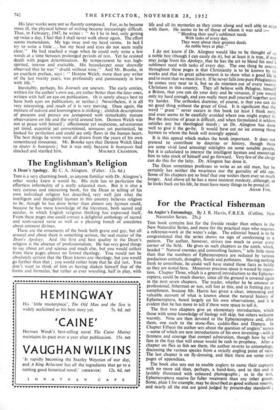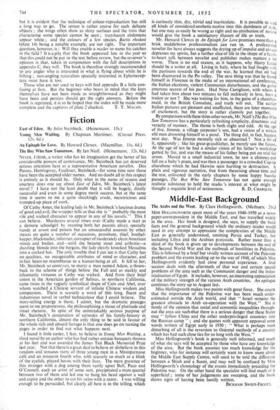For the Practical Fisherman
Tins book contains less for the fireside reader than others in the New Naturalist Series, and more for the practical man who requires a reference-work at the water's edge. The editorial board is to be congratulated that the series shows no sign of conforming to a pattern. The author, however, strives too much to cover every corner of the field. He gives us such chapters as the ninth, which, headed" Natural enemies and controlling factors," tells little more than that the numbers of Ephemeroptera are reduced by various predacious animals, droughts, floods and pollution. Having nothing fresh to contribute, he could well have stated those facts as baldly as they are stated here. Moreover precious space is wasted by repeti- tion. Chapter Three, which is a general introduction to the Epheme- roptera, could be much shorter, since all the ground is covered again in the next seven chapters. The reader, whether he be amateur or professional, fisherman or not, will fret at this, and in fretting pay a compliment, because Mr. Harris has given a clear, interesting and valuable account of what is known about the natural history of Ephemeroptera, based largely on his own observations, and it is evident that he has more to tell if there were space to tell it.
The first two chapters give an elementary introduction, which those with some knowledge of biology will skip, but others welcome warmly. Nine are then devoted to the Ephemeroptera and, after them, one each to the stone-flies, caddis-flies and Diptera. In Chapter Fifteen the author sets about the question of anglers' names —some of which are new introductions of his own inventing—with a firmness and courage that compel admiration, though how he will fare in the fray that will ensue would be rash to prophesy. After a chapter on flies as fish see them, the author reverts to entomology, discussing the various species from a strictly angling point of view. The last chapter is on fly-dressing, and then there are some sixty pages of appendices.
The book also sets out to enable anglers to name their captures with no more aid than, perhaps, a hand-lens, and to this end is lavishly illustrated with coloured photographs ; as in the text, Ephemeroptera receive far fuller treatment than any other' group. Some, plate 1 for example, may be described as good without reserve, and nearly all the rest are good judged by present-day standards ; but it is evident that the technique of colour-reproduction has still a long way to go. The screen is rather coarse for such delicate objects ; the wings often show as shiny surfaces and the tints that characterise some species cannot be seen ; translucent abdomens appear white ; and the colours of a few species, Baetis rhodani (plate 14) being a notable example, are not right. The important question, however, is : Will they enable a reader to name his catches in the field ? It is a pity that the book appeared late in the year so that this could not be put to the test before review, but the reviewer's opinion is that, taken in conjunction with the full descriptions in appendix C, they will. The book is therefore strongly recommended to any angler who is interested in what is flying about while he is fishing ; non-angling naturalists specially interested in Ephemerop- tera must have it too.
Those who are not used to keys will find appendix B a little con- fusing at first. But the beginner who bears in mind that the keys themselves have not been made as straightforward as they might have been and persists should get the right answers. Before the book is reprinted, it is to be hoped that the index will be made more complete and the captions of plate 2 checked. T. T. MACAN.



































 Previous page
Previous page